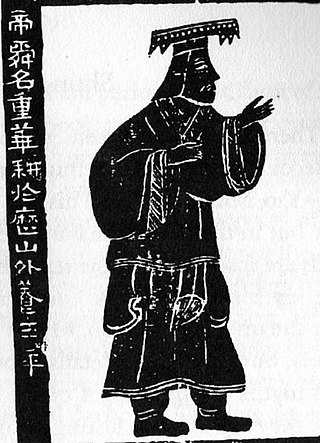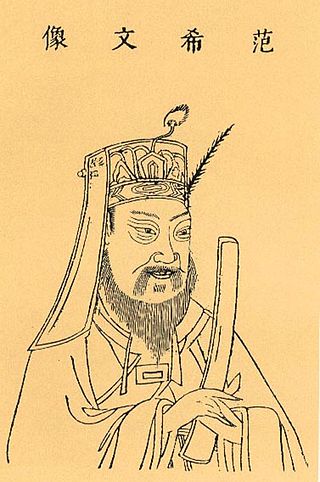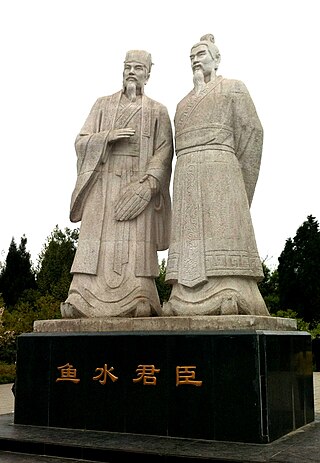
Chinese mythology is mythology that has been passed down in oral form or recorded in literature throughout the area now known as Greater China. Chinese mythology encompasses a diverse array of myths derived from regional and cultural traditions. Populated with engaging narratives featuring extraordinary individuals and beings endowed with magical powers, these stories often unfold in fantastical mythological realms or historical epochs. Similar to numerous other mythologies, Chinese mythology has historically been regarded, at least partially, as a factual record of the past.

The imperial examination was a civil service examination system in Imperial China administered for the purpose of selecting candidates for the state bureaucracy. The concept of choosing bureaucrats by merit rather than by birth started early in Chinese history, but using written examinations as a tool of selection started in earnest during the Sui dynasty (581–618) then into the Tang dynasty of 618–907. The system became dominant during the Song dynasty (960–1279) and lasted for almost a millennium until its abolition during the late Qing dynasty reforms in 1905. Aspects of the imperial examination still exist for entry into the civil service of contemporary China, in both the People's Republic of China (PRC) and the Republic of China (ROC).

Emperor Shun was a legendary leader of ancient China, regarded by some sources as one of the Three Sovereigns and Five Emperors being the last of the Five Emperors. Tradition holds that he lived sometime between 2294 and 2184 BC. Tradition also holds that those with surname Chen (陳) are descendants of Emperor Shun. The Duke Hu of Chen, a descendant of Shun, became the founder of the State of Chen. Later Chen dynasty emperors such as Chen Baxian would also claim descent from Shun.

Emperor Yao was a legendary Chinese ruler, according to various sources, one of the Three Sovereigns and Five Emperors.

Shennong (神農), variously translated as "Divine Farmer" or "Divine Husbandman", born Jiang Shinian (姜石年), was a mythological Chinese ruler known as the first Yan Emperor who has become a deity in Chinese and Vietnamese folk religion. He is venerated as a culture hero in China and Vietnam. In Vietnamese, he is referred to as Thần Nông.

Jinshi was the highest and final degree in the imperial examination in Imperial China. The examination was usually taken in the imperial capital in the palace, and was also called the Metropolitan Exam. Recipients are sometimes referred to in English-language sources as Imperial Scholars.

Fan Zhongyan, courtesy name Xiwen (希文), was a Chinese military strategist, philosopher, poet, and politician of the Song dynasty. After serving the central government for several decades, Fan was appointed Prime Minister or Chancellor over the entire Song empire. Fan's philosophical, educational and political contributions continue to be influential to this day, and his writings remain a core component of the Chinese literary canon. His attitude towards official service is encapsulated by his oft-quoted line on the proper attitude of scholar-officials: "They were the first to worry the worries of All-under-Heaven, and the last to enjoy its joys". Fan was a respected Confucian scholar and one of the most prominent members of the Fan family.

The grand chancellor, also translated as counselor-in-chief, chancellor, chief councillor, chief minister, imperial chancellor, lieutenant chancellor and prime minister, was the highest-ranking executive official in the imperial Chinese government. The term was known by many different names throughout Chinese history, and the exact extent of the powers associated with the position fluctuated greatly, even during a particular dynasty.
The Four Books and the Five Classics are authoritative and important books associated with Confucianism, written before 300 BC. They are traditionally believed to have been either written, edited or commented by Confucius or one of his disciples. Starting in the Han dynasty, they became the core of the Chinese classics on which students were tested in the Imperial examination system.

The Xiangshuishen or Xiang River Goddesses are goddesses of the Xiang River in Chinese folk religion. The Xiang flowed into Dongting Lake through the ancient kingdom of Chu, whose songs in their worship have been recorded in a work attributed to Qu Yuan. According to the Shanhaijing, the Xiang River deities were daughters of the supreme deity, Di. According to a somewhat later tradition, the Xiang goddesses were daughters of Emperor Yao, who were named Ehuang and Nüying who were said to have been married by him to his chosen successor, and eventually emperor, Shun, as a sort of test of his administrative abilities: then, later, they became goddesses, after the death of their husband.
The Music Bureau served in the capacity of an organ of various imperial government bureaucracies of China: discontinuously and in various incarnations, the Music Bureau was charged directly, by the emperor, or indirectly, through the royal government to perform various tasks related to music, poetry, entertainment, or religious worship. These tasks included both musical and lyrical research and development, and also directing performances.

Hou Ji was a legendary Chinese culture hero credited with introducing millet to humanity during the time of the Xia dynasty. Millet was the original staple grain of northern China, prior to the introduction of wheat. His name translates as Lord of Millet and was a title granted to him by Emperor Shun, according to Records of the Grand Historian. Houji was credited with developing the philosophy of Agriculturalism and with service during the Great Flood in the reign of Yao; he was also claimed as an ancestor of the Ji clan that became the ruling family of the Zhou dynasty or a founder of the Zhou.
The Great Flood of Gun-Yu, also known as the Gun-Yu myth, was a major flood in ancient China that allegedly continued for at least two generations, which resulted in great population displacements among other disasters, such as storms and famine. People left their homes to live on the high hills and mountains, or nest on the trees. According to mythological and historical sources, it is traditionally dated to the third millennium BCE, or about 2300-2200 BCE, during the reign of Emperor Yao.
Jiang Yuan is an important figure in Chinese mythology and history. She is recorded as having lived during ancient Chinese history. Jiang Yuan was the mother of Houji, who is a culture hero and revered as the god of millet.
Four Mountains or Four Peaks variously interpreted from Chinese mythology or the most ancient level of Chinese history as being a person or four persons or four gods, depending upon the specific source. The ambiguous Four Mountains feature prominently in the myth of the Great Flood, and the related myths of Emperor Yao, Gun, Shun, and Yu the Great.

Zhou, known in historiography as the Wu Zhou, Southern Zhou, Second Zhou or Restored Zhou, was a short-lived Chinese imperial dynasty that existed between 690 and 705, when Wu Zhao ruled as empress regnant. The dynasty began when Wu Zhao usurped the throne of her son, the Emperor Ruizong of Tang, and lasted until the Emperor Zhongzong of Tang was restored to the throne in the Shenlong Coup. Historians generally view the Wu Zhou as an interregnum of the Tang dynasty.

The Yellow River Map, Scheme, or Diagram, also known by its Chinese name as the Hetu, is an ancient Chinese diagram that appears in myths concerning the invention of writing by Cangjie and other culture heroes. It is usually paired with the Luoshu Square—named in reference to the Yellow River's Luo tributary—and used with the Luoshu in various contexts involving Chinese geomancy, numerology, philosophy, and early natural science.

The administration of territory in dynastic China is the history of practices involved in governing the land from the Qin dynasty to the Qing dynasty (1636–1912).

Religion in the Song dynasty (960–1279) was primarily composed of three institutional religions: Confucianism, Taoism, and Buddhism, in addition to Chinese folk religion. The Song period saw the rise of Zhengyi Taoism as a state sponsored religion and a Confucian response to Taoism and Buddhism in the form of Neo-Confucianism. While Neo-Confucianism was initially treated as a heterodox teaching and proscribed, it later became the mainstream elite philosophy and the state orthodoxy in 1241.

















